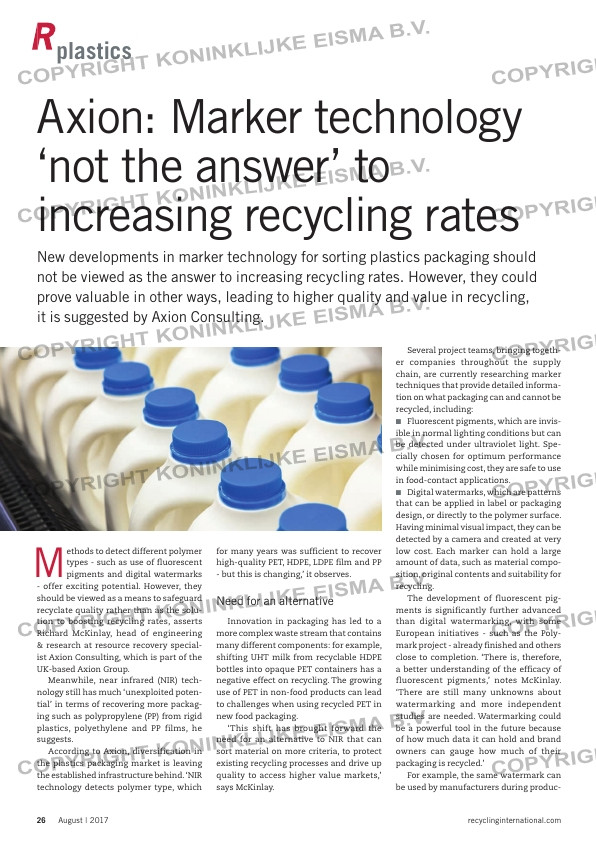Page 28 from: Edition 5 2017

26 August | 2017 recyclinginternational.com
plastics
Axion: Marker technology
‘not the answer’ to
increasing recycling rates
New developments in marker technology for sorting plastics packaging should
not be viewed as the answer to increasing recycling rates. However, they could
prove valuable in other ways, leading to higher quality and value in recycling,
it is suggested by Axion Consulting.
M
ethods to detect different polymer
types – such as use of fluorescent
pigments and digital watermarks
– offer exciting potential. However, they
should be viewed as a means to safeguard
recyclate quality rather than as the solu-
tion to boosting recycling rates, asserts
Richard McKinlay, head of engineering
& research at resource recovery special-
ist Axion Consulting, which is part of the
UK-based Axion Group.
Meanwhile, near infrared (NIR) tech-
nology still has much ‘unexploited poten-
tial’ in terms of recovering more packag-
ing such as polypropylene (PP) from rigid
plastics, polyethylene and PP films, he
suggests.
According to Axion, diversification in
the plastics packaging market is leaving
the established infrastructure behind. ‘NIR
technology detects polymer type, which
for many years was sufficient to recover
high-quality PET, HDPE, LDPE film and PP
– but this is changing,’ it observes.
Need for an alternative
Innovation in packaging has led to a
more complex waste stream that contains
many different components: for example,
shifting UHT milk from recyclable HDPE
bottles into opaque PET containers has a
negative effect on recycling. The growing
use of PET in non-food products can lead
to challenges when using recycled PET in
new food packaging.
‘This shift has brought forward the
need for an alternative to NIR that can
sort material on more criteria, to protect
existing recycling processes and drive up
quality to access higher value markets,’
says McKinlay.
Several project teams, bringing togeth-
er companies throughout the supply
chain, are currently researching marker
techniques that provide detailed informa-
tion on what packaging can and cannot be
recycled, including:
■■ Fluorescent pigments, which are invis-
ible in normal lighting conditions but can
be detected under ultraviolet light. Spe-
cially chosen for optimum performance
while minimising cost, they are safe to use
in food-contact applications.
■■ Digital watermarks, which are patterns
that can be applied in label or packaging
design, or directly to the polymer surface.
Having minimal visual impact, they can be
detected by a camera and created at very
low cost. Each marker can hold a large
amount of data, such as material compo-
sition, original contents and suitability for
recycling.
The development of fluorescent pig-
ments is significantly further advanced
than digital watermarking, with some
European initiatives – such as the Poly-
mark project – already finished and others
close to completion. ‘There is, therefore,
a better understanding of the efficacy of
fluorescent pigments,’ notes McKinlay.
‘There are still many unknowns about
watermarking and more independent
studies are needed. Watermarking could
be a powerful tool in the future because
of how much data it can hold and brand
owners can gauge how much of their
packaging is recycled.’
For example, the same watermark can
be used by manufacturers during produc-



